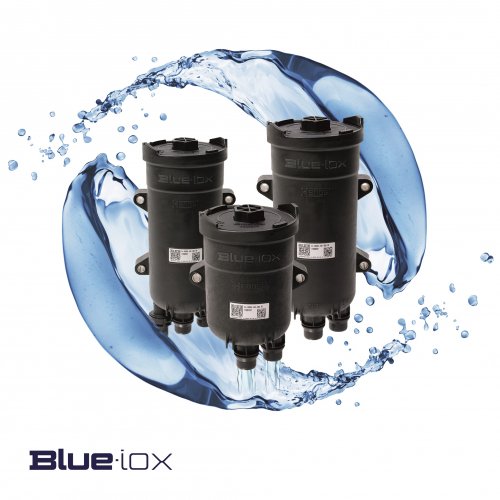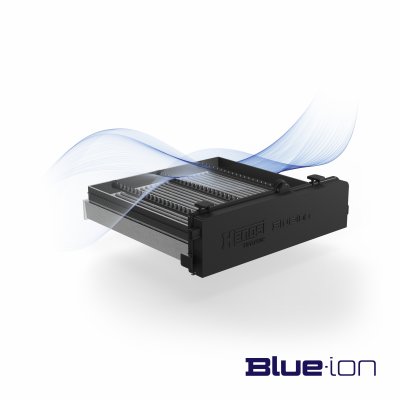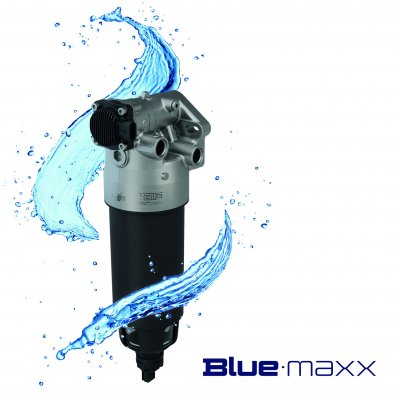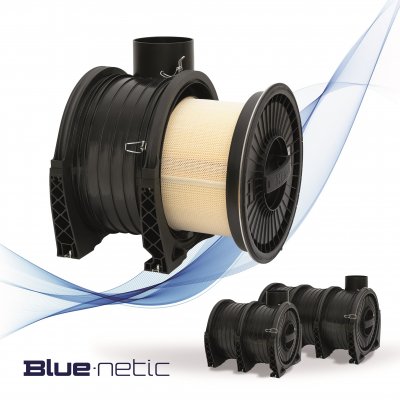Under the motto “Filtration on the Move”, Hengst is presenting innovative products for liquid and air filtration at the IAA Transportation in Hanover (17.-22.9.2024) as well as a world first: a completely CO2 -neutral filter.

Hengst_Blue.iox_IAA_PR.jpg: The innovative Blue.iox ion exchanger offers a particularly high level of protection with minimal maintenance
The path to CO2 -neutral mobility of the future is increasingly shaking up markets worldwide and accelerating change in the automotive and engine industry. Hengst, a specialist in filtration and fluid management, is consistently aligning its product range with future requirements. In order to be able to continue to offer drive and vehicle manufacturers a wide range of innovative solutions, Hengst has pooled its resources in the field of basic research and pre-development at the TechCenter Filtration in Münster. The developers there are researching issues of the future and developing solutions that contribute to the success of the mobility transition and energy transformation, for example. At the IAA Transportation in Hanover, the company will be demonstrating how innovative products from Hengst help to reduce environmental and air pollution, among other things.
Electrified cabin air filter Blue.ion
In the field of air filtration, Hengst utilizes its many years of expertise in industrial filtration, on the basis of which it is increasingly developing products for original vehicle equipment. One example is the Blue.ion cabin air filter. It achieves its filter effect through a combination of ionization of the particles in the air flow and polarization of the filter medium. The ionizer is located directly in front of the filter and ensures that the particles are electrostatically charged. This makes it easier to separate them in the filter, which is also charged. However, ionization alone would reduce the charge in the filter over time and lead to a loss of performance with reduced particle separation. At this point, polarization has a complementary effect. By building up an electrostatic field, the charge in the filter medium is permanently maintained.

Hengst_Blue.ion_IAA_PR.jpg: The innovative Blue.ion. cabin air filter achieves its filter effect through a combination of ionization of the particles in the air flow and polarization of the filter medium.
Overall, the combined system ensures a consistently high level of separation over the entire service life. The Blue.ion also impresses with its high and energy-efficient filtration performance. It removes even the finest particles (PM1: particle size 1 mm and smaller) from the intake air, thereby offering maximum protection against pollutants, viruses and allergens and making a significant contribution to a healthy and hygienic interior climate in the vehicle.
Nevertheless, it has a compact design – conventional filters require around five times more installation space for the same differential pressure – and offers low flow resistance even when filtering the finest particles. This means less energy consumption by the fan and lower noise emissions. Here too, the Blue.ion is ahead of conventional filters, which have to work with a five times higher differential pressure to achieve the same performance values.
Solutions for alternative fuels (e-fuels, FAME, HVO )
The defossilization of the transport sector, but also of off-highway and stationary applications, makes a broad mix of different drive and fuel concepts necessary. This diversification takes into account the countless special requirements in the many different segments and the specific conditions in the various regions worldwide. Depending on the area of application, electric drives with batteries and/or fuel cells as well as combustion engines with synthetic fuels such as e-fuels and hydrogen or with biofuels such as hydrogenated vegetable oils (HVO) or fatty acid methyl esters (FAME) are used.
Hengst continues to develop its fuel filter concepts so that they can also be used with alternative fuels. The Blue.maxx fuel filter system, for example, is suitable for all current and future fuels used worldwide – whether fossil, biogenic or synthetic. In order to meet the diverse requirements of modern engine technology in the commercial vehicle and off-highway sectors, Hengst has designed the system with a modular structure so that it can be quickly and easily adapted to different applications as an original equipment or retrofit solution. Depending on the separation, fineness and fuel requirements, various single or multi-layer elements of the Energetic fuel filter insert are available.
The Blue.maxx system can be designed in two parts as a pre-filter and main filter or as a combined main filter with integrated water separation. The modular system contains four basic variants for volume flows of 50 to 750 litres/hour, which can be individually adapted using various additional elements.

Hengst_Blue.maxx_IAA_PR.jpg: The Blue.maxx fuel filter system, for example, is suitable for all current and future fuels used worldwide
Filter systems for hydrogen engines and fuel cells
When developing combustion engines that run on hydrogen, a potentially increased accumulation of water in the engine oil and the easy flammability of hydrogen must be taken into account. If unfavorable engine operating conditions are likely to cause water to enter the engine oil, Hengst offers specially designed fully synthetic filter elements and sealing materials. The oil filter modules from Hengst can be flexibly configured and cover the specific requirements of hydrogen as well as other alternative fuels such as FAME or HVO. In hydrogen engines, blow-by gases that enter the crankcase via the cylinders can form an explosive mixture.
An innovative active ventilation system from Hengst minimizes the hydrogen concentration in the crankcase and effectively counteracts the risk of ignition. It consists of specially developed air valves through which fresh air is fed directly into the crankcase, so that there is always a positive pressure gradient to the crankcase. Hengst has developed the active ventilation as part of an overall filter concept for hydrogen engines, which also consists of the electrically driven Blue.tron disk separator. Depending on the speed and load of the combustion engine, an optimum separation rate is always achieved for the engine oil in the blow-by flow.

Hengst_Blue.netic_IAA_PR.jpg : A modular cathode air filter system from Hengst with a multi-layer structure protects the components of the fuel cell.
In fuel cells, ions are introduced into the coolant during operation due to ageing. Effective filtration is therefore required to ensure safe operation. The innovative Blue.iox ion exchanger from Hengst offers a particularly high level of protection with minimal maintenance. The unique design of the filter cartridge with axial filter flow and the special mixed bed resin system for cation and anion exchange ensure high filtration efficiency over the entire service interval. The ion concentration in the coolant circuit of the fuel cell is thus reduced very quickly.
The air path of a fuel cell also places special demands on filtration. In order to achieve a long service life and high performance, the intake air must be cleaned very effectively of particles and substances such as nitrogen oxides, ammonia and sulphur oxide. A specially developed cathode air filter system from Hengst with a multi-layer structure protects the components of the fuel cell. Thanks to its modular design, the system can cover a wide power range of fuel cells from 100 to 500 kilowatts. In addition to products for coolant and air filtration, Hengst also develops solutions for system integration directly on the fuel cell stack. One example of this is a water separator for anode gas recirculation, which is characterized by an innovative valve configuration of the purge and drain valve.

